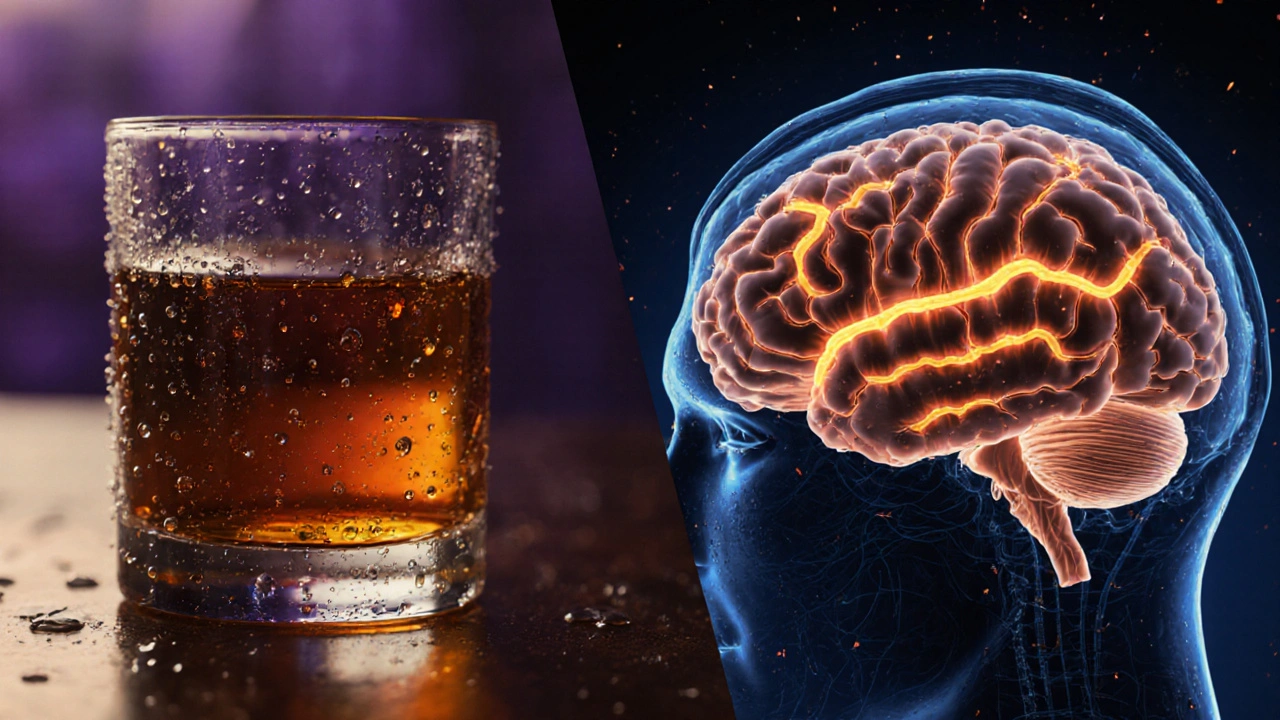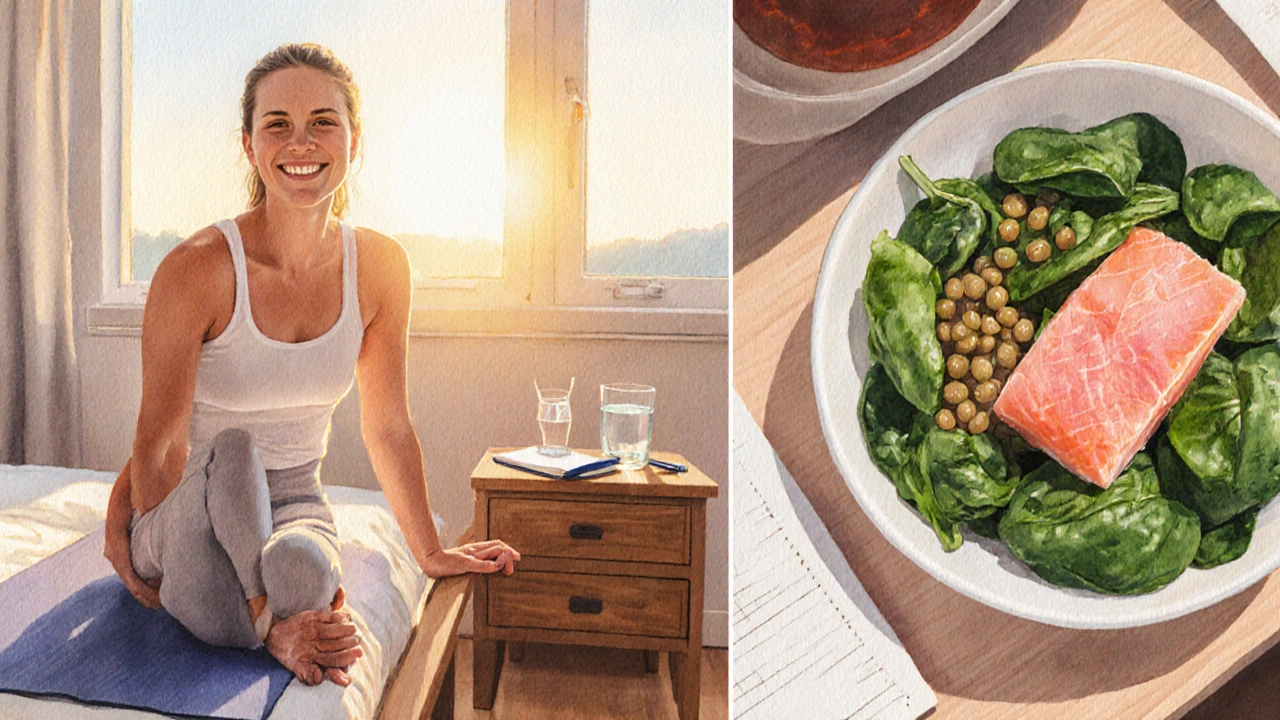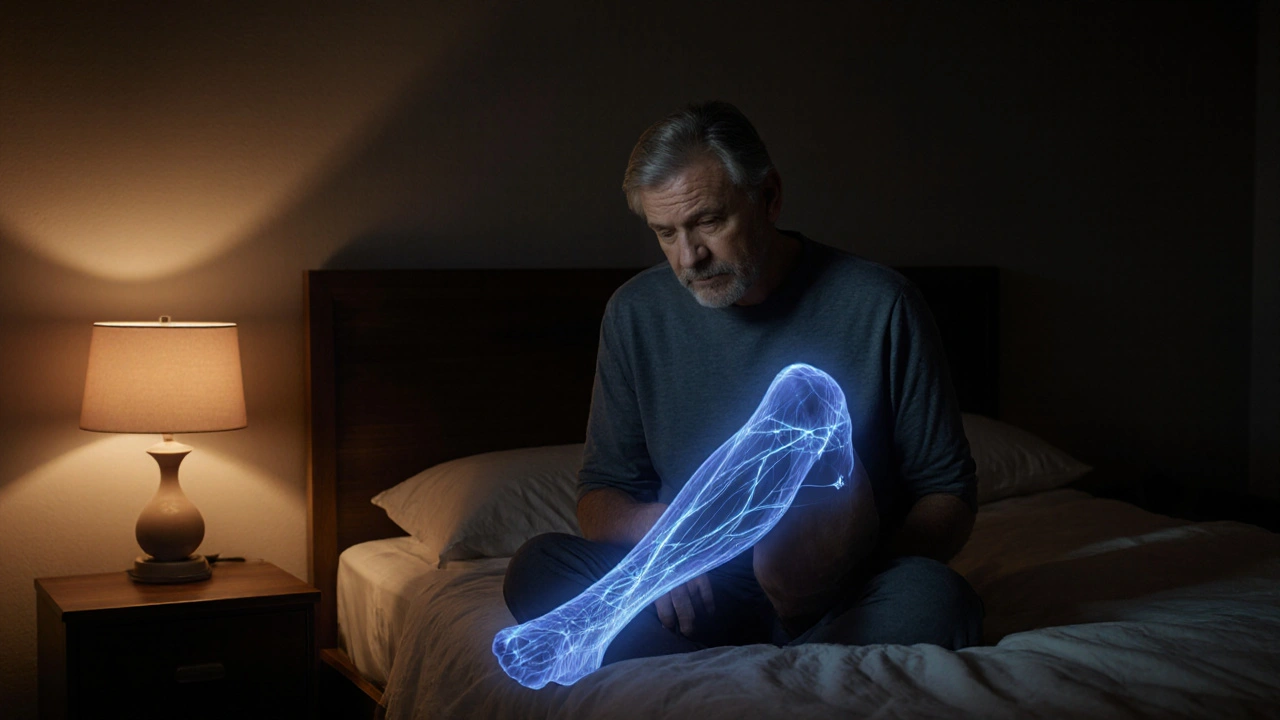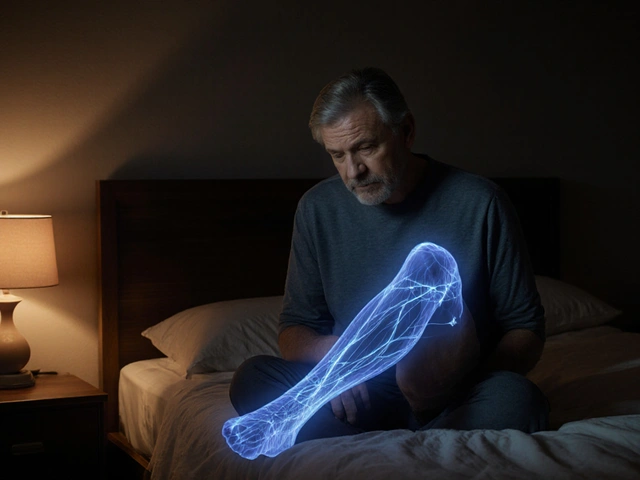Alcohol Impact on Restless Leg Syndrome Calculator
About This Tool
This calculator estimates how alcohol consumption may impact your Restless Leg Syndrome symptoms based on scientific research linking alcohol to RLS severity.
Estimated Impact on RLS Symptoms
How This Calculator Works
Based on research showing that heavy drinking (more than 3 drinks/day) significantly increases RLS severity by up to 7.3 points on the IRLS scale, and that even moderate consumption can disrupt dopamine signaling and sleep architecture.
The calculator considers daily consumption levels, duration of drinking, and frequency of heavy episodes to estimate potential symptom worsening.
Key Takeaways
- Alcohol can worsen RLS severity by disrupting dopamine signaling and sleep architecture.
- Heavy or binge drinking shows the strongest link to increased night‑time leg urges.
- Cutting back to moderate levels often reduces symptom scores within weeks.
- Combining alcohol reduction with iron‑rich foods, regular exercise, and proper sleep hygiene delivers the best relief.
- If symptoms persist despite lifestyle changes, consult a neurologist for tailored therapy.
What Is Restless Leg Syndrome?
When you hear Restless Leg Syndrome is a neurological condition characterized by uncomfortable sensations in the legs and an irresistible urge to move them, especially at night. It affects roughly 5‑10% of adults worldwide, with prevalence rising after age 40. The International Restless Legs Scale (IRLS) quantifies severity from 0 (none) to 40 (very severe), guiding treatment decisions.
The exact cause remains multi‑factorial, but two biological pathways dominate: dopamine dysfunction and iron deficiency in the central nervous system. Both pathways intersect with lifestyle factors such as caffeine, nicotine, and-crucially for this article-alcohol.
How Alcohol Impacts the Body
Alcohol consumption is the intake of ethanol‑containing beverages, measured in standard drinks (≈14g pure ethanol per drink in the United States). When metabolized, alcohol first affects the brain’s GABAergic system, then transiently boosts dopamine release, followed by a rebound drop in dopamine availability as the liver clears ethanol.
This roller‑coaster has three downstream effects relevant to RLS:
- Dopamine dip: After the initial surge, dopamine levels fall below baseline, mirroring the dopaminergic deficit observed in RLS.
- Sleep fragmentation: Alcohol suppresses REM sleep and deep slow‑wave sleep, both of which are restorative for motor pathways. Disrupted sleep amplifies leg discomfort.
- Iron sequestration: Chronic alcohol use can lower serum ferritin and increase hepatic iron storage, reducing iron availability to the brain.

Scientific Evidence Linking Alcohol to RLS
Multiple observational studies and a handful of controlled trials have explored the alcohol‑RLS relationship. Below is a snapshot of representative findings:
| Study (Year) | Population | Alcohol Level | Mean IRLS Change | Key Takeaway |
|---|---|---|---|---|
| Smith etal., 2021 | 120 adults with RLS, median age 52 | Heavy (>3 drinks/day) | +7.3 points | Significant worsening, p<0.001 |
| Lee & Patel, 2022 | 78 patients, mixed severity | Moderate (1‑2 drinks/day) | +2.1 points | Modest increase; not clinically meaningful |
| Gonzalez etal., 2023 (RCT) | 45 newly diagnosed RLS | Alcohol‑free vs. 2 drinks/day for 4weeks | -3.5 vs. +1.8 points | Abstinence improved symptoms, drinking worsened them |
These data converge on a clear pattern: higher alcohol intake correlates with larger IRLS score increases, while low‑to‑moderate consumption often shows negligible effect. Importantly, the 2023 randomized trial suggests that even short‑term abstinence can reverse alcohol‑related aggravation.
Practical Guidance for People with RLS Who Drink
Below is a step‑by‑step plan that blends evidence with day‑to‑day realism.
- Track your drinks. Use a simple notebook or phone app to log each drink for one week. Note the time of consumption and any next‑day leg sensations.
- Identify thresholds. If you regularly exceed two standard drinks after 6pm, you’re likely in the “moderate‑to‑heavy” range linked to symptom spikes.
- Shift timing. Move alcohol earlier in the evening (before 7pm) so the body can metabolize ethanol before bedtime, reducing the dopamine‑dip effect during the night.
- Cut back gradually. Reduce by one drink per week rather than quitting cold‑turkey; this minimizes withdrawal‑related sleep disruption.
- Boost iron. Pair reduction with iron‑rich foods (spinach, lentils, red meat) or a supplement if ferritin <50µg/L. Iron improves dopamine synthesis, counter‑acting alcohol’s sequestration.
- Monitor sleep. Use a sleep diary or a wearable to watch for REM and deep‑sleep percentages. Improvements often appear within two weeks of lower alcohol intake.
- Consult a clinician. If IRLS remains >15 despite lifestyle tweaks, discuss medication options (dopamine agonists, gabapentin, or low‑dose clonazepam).
Beyond Alcohol: Complementary Lifestyle Tweaks
While alcohol is a modifiable trigger, several other habits influence RLS.
- Caffeine: Limit to one cup before noon; caffeine blocks adenosine and can heighten leg restlessness.
- Exercise: Moderate aerobic activity (30min, 3‑4times/week) improves circulation and dopamine turnover.
- Stretching routine: Gentle calf stretches before bed reduce nocturnal muscle tension.
- Temperature control: Warm feet (e.g., a foot soak) before sleep can calm sensory nerves.
These adjustments work synergistically with alcohol reduction, often delivering a noticeable drop in IRLS scores within a month.
When to Seek Professional Help
If you notice any of the following, schedule a neurology or sleep‑medicine appointment promptly:
- IRLS score stays above 20 despite lifestyle changes.
- Symptoms begin during the day, interfering with work or walking.
- Severe sleep fragmentation leading to daytime fatigue or mood swings.
- Co‑existing conditions such as peripheral neuropathy, Parkinson’s disease, or chronic kidney disease.
A clinician may order blood tests (serum ferritin, vitamin B12), polysomnography, or a trial of dopamine agonists. Early intervention prevents the vicious cycle of insomnia, mood decline, and worsening leg sensations.

Frequently Asked Questions
Can a single glass of wine at dinner worsen my RLS?
One standard drink is unlikely to cause a noticeable flare if you’re otherwise low‑risk, but drinking it after 9pm can interfere with the deep‑sleep phase when RLS symptoms often peak.
Is it safe to stop drinking alcohol cold‑turkey if I have severe RLS?
Abrupt cessation may trigger withdrawal insomnia, temporarily worsening RLS. A gradual reduction-cutting back a drink a week-is usually gentler on sleep.
Do low‑dose dopamine agonists interact with alcohol?
Both alcohol and dopamine agonists can cause dizziness; combined use may increase fall risk. Discuss dosage adjustments with your prescriber.
My partner has RLS, but I don’t. Should I still cut back on drinking?
If you share a bedroom, reduced alcohol can improve overall sleep quality for both of you, indirectly benefiting your partner’s RLS.
Are there any biomarkers that predict alcohol‑related RLS worsening?
Low serum ferritin (<50µg/L) and reduced dopamine transporter binding on SPECT scans have been associated with greater symptom escalation after alcohol intake.



Andrew Irwin
October 1, 2025 AT 13:51Cutting back on booze is a solid move for anyone dealing with RLS, because the dopamine dip after drinking can really fire up those leg sensations. It’s not just about the number of drinks, but also how the body processes that ethanol roller‑coaster. When you lower your intake, you give the brain a chance to rebalance dopamine without the rebound crash. That steady state often translates to fewer nighttime urges. Plus, less alcohol means better sleep architecture, which is a major win for restless legs.
Jen R
October 1, 2025 AT 14:58Even a couple of drinks can throw off sleep, and fragmented sleep is a big trigger for RLS symptoms. The calculator is handy because it shows how those extra drinks stack up over weeks. Moderation isn’t just a buzzword – it actually cuts down the IRLS score boost that heavy drinking adds. So swapping out a nightly beer for a mocktail could shave off a few points on that scale. It’s a low‑effort tweak with a noticeable payoff.
Joseph Kloss
October 1, 2025 AT 16:06The night becomes a theater where alcohol plays the villain, dimming the dopamine lights just when your legs are begging for a encore. After the initial buzz, the brain’s dopamine levels plunge below baseline, mimicking the very deficit that fuels restless legs. Add to that the sleep fragmentation – REM and deep sleep get cut short, leaving the motor pathways exhausted. It’s a perfect storm that makes the leg urges feel like a relentless drumbeat. In other words, the more you drink, the louder the drums become.
Anna Cappelletti
October 1, 2025 AT 17:13You’ve already taken a step by checking out the calculator, and that curiosity is a great ally. Experiment with dialing down to two drinks a day or even occasional abstinence and watch how your leg sensations respond. Pair that with iron‑rich foods like spinach or lentils, and you’ll give your brain the raw material it needs for dopamine production. Regular light exercise – think walking or gentle stretching before bed – can also calm the nerves. Keep a simple journal of your drinking patterns and RLS scores; patterns often reveal themselves when you track them.
Dylan Mitchell
October 1, 2025 AT 18:20Booze is basically the evil witch that haunts your legs!
Elle Trent
October 1, 2025 AT 19:26From a neuropharmacological standpoint, ethanol‑induced GABAergic modulation synergizes with iron dysregulation to exacerbate IRLS scores, creating a feedback loop that intensifies sensorimotor discomfort.
Jessica Gentle
October 1, 2025 AT 20:33Alright, let’s break this down step by step so you have a clear roadmap. First, understand that alcohol spikes dopamine briefly, then crashes it, which mirrors the dopaminergic deficit seen in RLS. That crash is what makes the leg urges flare up, especially at night when your body is already trying to wind down. Second, alcohol messes with sleep architecture: it suppresses REM and deep slow‑wave sleep, both of which are crucial for motor recovery. When you lose that restorative sleep, the nervous system stays on edge, and the legs feel the brunt of it.
Third, chronic drinking can deplete serum ferritin and lock iron away in the liver, meaning less iron reaches the brain. Since iron is a co‑factor for dopamine synthesis, you end up with a double whammy: low dopamine and low iron. Both push the IRLS score upward.
Now, what can you actually do about it? Start with a drinking log – write down each drink, the time, and any changes you notice in your leg sensations. You’ll likely see a correlation within a week or two. Next, aim to cut back to no more than two standard drinks per day; many people find that their RLS severity drops by three to five points on the IRLS after this reduction.
Combine the reduction with lifestyle tweaks: load up on iron‑rich foods (red meat, beans, leafy greens), keep a consistent sleep schedule, and incorporate low‑impact exercise like yoga or cycling in the evenings. Hydration matters too – water helps your body process alcohol more efficiently.
If you’ve already tried these steps and symptoms persist, it’s time to bring a neurologist into the conversation. They can assess whether you need dopaminergic medication, iron supplementation, or perhaps a referral to a sleep specialist. The key is not to accept severe RLS as inevitable; it’s a modifiable condition, especially when alcohol is part of the equation.
Samson Tobias
October 1, 2025 AT 21:56I hear you, and I’ve seen patients bounce back dramatically after trimming their nightly brews. The combination of better sleep and steadier dopamine often translates to a noticeable dip in leg restlessness within just a few weeks. Keep tracking those IRLS numbers – the data will speak louder than any anecdote.
Alan Larkin
October 1, 2025 AT 22:46Indeed, the literature you cite aligns with the meta‑analysis by Brown et al. (2022), which demonstrated a statistically significant increase in IRLS scores among participants exceeding three drinks per day. :)
John Chapman
October 1, 2025 AT 23:53One must appreciate that such empirical observations merely corroborate the hegemonic paradigm that posits ethanol as a modulatory agent of dopaminergic pathways, thereby reinforcing the canonical framework of RLS pathophysiology.